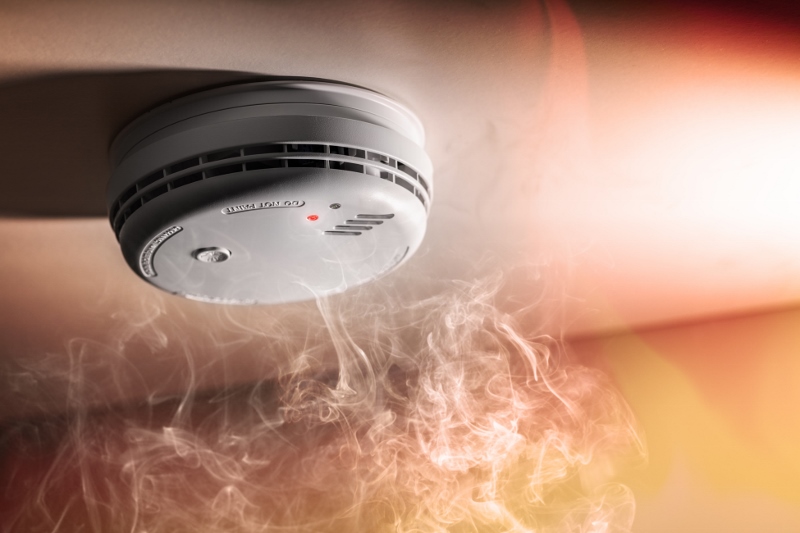Article by Dale Grant – Marketing Coordinator
Smoke detectors are a key piece of technology in both commercial Fire Prevention and Life Safety Systems as well as residential. These devices work by utilizing different technologies to detect smoke and alert occupants to potential fire hazards. Historically, there have been primarily two types of smoke detectors: ionization and photoelectric detectors, each with its own history, working principles, and advantages. However, advancements in technology have lead to the emergence of some interesting new Smoke Detector types as well. Understanding the differences between these technologies is crucial for choosing the most appropriate detector for specific environments.
A Little Background
The concept of smoke detection devices dates back to the early 20th century, with the first automatic electric fire alarm patented in 1890 by Francis Robbins Upton. However, it wasn’t until the 1930s that the first practical smoke detector was developed. In 1931, George Andrew Darby created the first ionization smoke detector, which utilized radioactive materials to detect smoke particles.
A few years later, photoelectric smoke detectors emerged later, with the first patent filed in 1939 by Swiss physicist Walter Jaeger. However, commercial production of photoelectric detectors began in the 1970s, gaining popularity due to their effectiveness in detecting slow, smoldering fires.
Ionization Smoke Detectors
Ionization smoke detectors work on the principle of ionizing radiation. Inside the detector, there are two plates with a small amount of radioactive material, typically americium-241, between them. This material emits alpha particles, which ionize the air between the plates, creating a small electrical current.
When smoke enters the chamber, it disrupts the ionization process, reducing the electrical current. This drop in current triggers the alarm, indicating the presence of smoke. Ionization detectors are particularly sensitive to fast-burning, flaming fires that produce small smoke particles.
One of the advantages of ionization detectors is their affordability and widespread availability. They are also more responsive to flaming fires, making them suitable for areas with a higher risk of this type of fire, such as kitchens.
Photoelectric Smoke Detectors
Photoelectric smoke detectors operate based on light scattering principles. These detectors contain a light source, usually an LED, and a photodetector. When smoke enters the chamber, it scatters the light, causing it to reach the photodetector. This disruption in the light pattern triggers the alarm.
Unlike ionization detectors, photoelectric detectors are more effective at detecting slow, smoldering fires that produce larger smoke particles. These types of fires can occur in areas with smoldering materials like upholstery, bedding, or electrical components.
One of the significant advantages of photoelectric smoke detectors is their ability to detect smoke before it develops into a full-blown fire. This early detection can provide occupants with valuable time to evacuate safely or take appropriate measures to extinguish the fire.

Key Differences
Detection Method: Ionization detectors rely on the disruption of ionization currents by smoke particles, while photoelectric detectors detect smoke through light scattering.
Fire Types: Ionization detectors are more responsive to fast-burning, flaming fires, while photoelectric detectors are better at detecting slow, smoldering fires.
Sensitivity: Ionization detectors are generally more sensitive and can detect smaller smoke particles, but they may also be prone to false alarms. Photoelectric detectors are less prone to false alarms but may be slower to respond to fast burning, flaming fires as compared to their Ionization counterparts.
Applications: Ionization detectors are commonly used in areas where flaming fires are more likely, such as kitchens or garages. Photoelectric detectors are suitable for areas with smoldering materials, such as bedrooms or living rooms.
Advancements in technology
In recent years, dual-sensor smoke detectors combining both ionization and photoelectric technologies have become available. These detectors offer the benefits of both technologies, providing comprehensive smoke detection capabilities and reducing the risk of false alarms.
One of the primary benefits of dual-sensor smoke detectors is their ability to detect a wide range of fire types effectively. By utilizing ionization technology, these detectors can quickly respond to fast-burning, flaming fires that produce small smoke particles. At the same time, the inclusion of photoelectric technology allows them to detect slow, smoldering fires that emit larger smoke particles. This dual-sensor approach ensures that the detector can effectively detect fires regardless of their ignition speed or smoke particle size. It is important to note, however, that due to the radioactive material required for dual-sensor smoke detectors and ionization detectors in general, as well as advancements in multicriteria/ Intelligent Alarms, they have begun a phasing out process, with dual-sensor alarms typically only being used in residential applications.
Multicriteria or Intelligent Alarms utilize a combination of various sensors like photoelectric, ionization, and heat, coupled with an algorithm, to detect fires. This design incorporates multiple sensors to enhance the alarm’s ability to differentiate between genuine fire threats and non-fire sources, such as cooking activities, thereby minimizing unwanted or “nuisance” alarms. However, it’s important to note that while these alarms excel at reducing false alarms, their ability to detect fires earlier is not necessarily guaranteed. Additionally, the industry is seeing technological advancements including built in Carbon Monoxide Detectors and longer lasting batteries in residential smoke detectors.
Regardless of your project, it is always best to speak with a Life Safety Systems Specialist to determine which type of smoke detector best suits the needs of your project. Contact Oliver Fire Protection & Security for a FREE Consultation.

